The Intel Xeon E7-8800 v3 Review: The POWER8 Killer?
by Johan De Gelas on May 8, 2015 8:00 AM EST- Posted in
- CPUs
- IT Computing
- Intel
- Xeon
- Haswell
- Enterprise
- server
- Enterprise CPUs
- POWER
- POWER8
Xeon E7 v3 System and Memory Architecture
So, the Xeon E5 "Haswell EP" and Xeon E7 "Haswell EX" are the same chip, but the latter has more features enabled and as result it finds a home in a different system architecture.
Debuting alongside the Xeon E7 v3 is the new "Jordan Creek 2" buffer chip, which offers support for DDR4 LR-DIMMs or buffered RDIMMs. However if necessary it is still possible to use the original "Jordan Creek" buffer chips with DDR3, giving the Xeon E7 v3 the ability to be used with either DDR3 or DDR4. Meanwhile just like its predecessor, the Jordan Creek 2 buffers can either running in lockstep (1:1) or in performance mode (2:1). If you want more details, read our review of the Xeon E7 v2 or Intel's own comparison.
To sum it up, in lockstep mode (1:1):
- The Scalable Memory Buffer (SMB) is working at the same speed as the RAM, max. 1866 MT/s.
- Offers higher availability as the memory subsystem can recover from two sequential RAM failures
- Has lower bandwidth as the SMB is running at max. 1866 MT/s
- ...but also lower energy for the same reason (about 7W instead of 9W).
In performance mode (2:1):
- You get higher bandwidth as the SMB is running at 3200 MT/s (Xeon E7 v2: 2667 MT/s), twice the speed of the memory channels. The SMB combines two memory channels of DDR-4 1600.
- Higher energy consumption as the SMB is running at full speed (9W TDP, 2.5 W idle)
- The memory subsystem can recover from one device/chip failure as the data can be reconstructed in the spare chip thanks to the CRC chip.
This is a firmware option, so you chose once whether being able to lose 2 DRAM chips is worth the bandwidth hit.
Xeon E7 vs E5
The different platform/system architecture is the way that the Xeon E7 differentiates itself from the Xeon E5, all the while both chips have what is essentially the same die. Besides being able to use 4 and 8 socket configurations, the E7 supports much more memory. Each socket connects via Scalable Memory Interconnect 2 (SMI2) to four "Jordan Creek2" memory controllers.
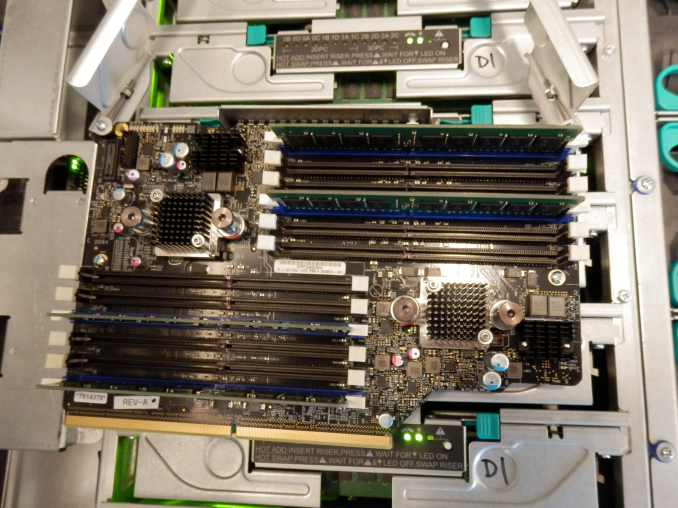 Jordan Creek 2 memory buffers under the black heatsinks with 6 DIMM slots
Jordan Creek 2 memory buffers under the black heatsinks with 6 DIMM slots
Each of these memory buffers supports 6 DIMM slots. Multiply four sockets with four memory buffers and six dimm slots and you get a total of 96 DIMM slots. With 64 GB LR-DIMMs (see our tests of Samsung/IDT based LRDIMMs here) in those 96 DIMM slots, you get an ultra expensive server with no less than 6 TB RAM. That is why these system are natural hosts for in-memory databases such as SAP HANA and Microsoft's Hekaton.
There is more of course. Chances are uncomfortably high that with 48 Trillion memory cells that one of those will go bad, so you want some excellent reliability features to counter that. Memory mirroring is nothing new, but the Xeon E7 v3 allows you to mirror only the critical part of your memory instead of simply dividing capacity by 2. Also new is "multiple rank sparing", which provides dynamic failover of up to four ranks of memory per memory channel. In other words, not can the system shrug off a single chip failure, but even a complete DIMM failure won't be enough to take the system down either.


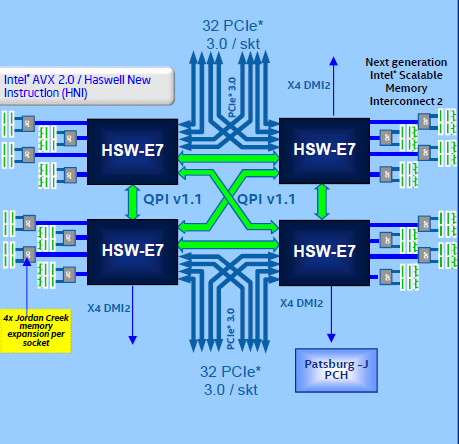
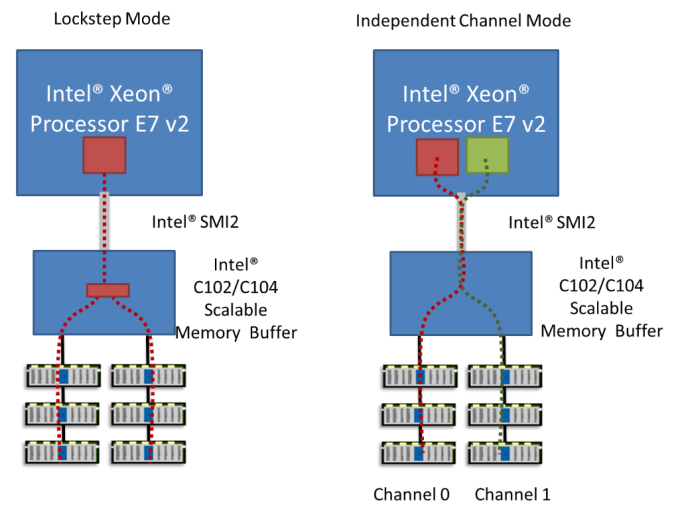
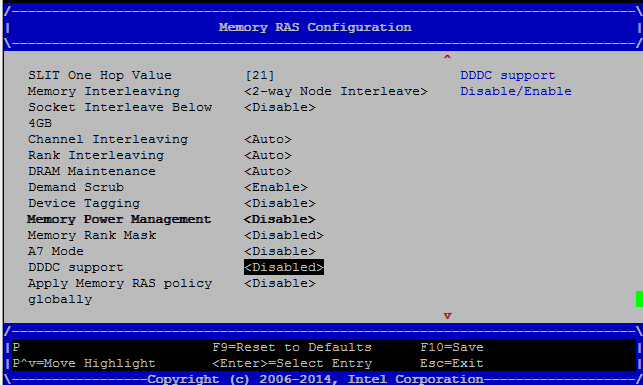
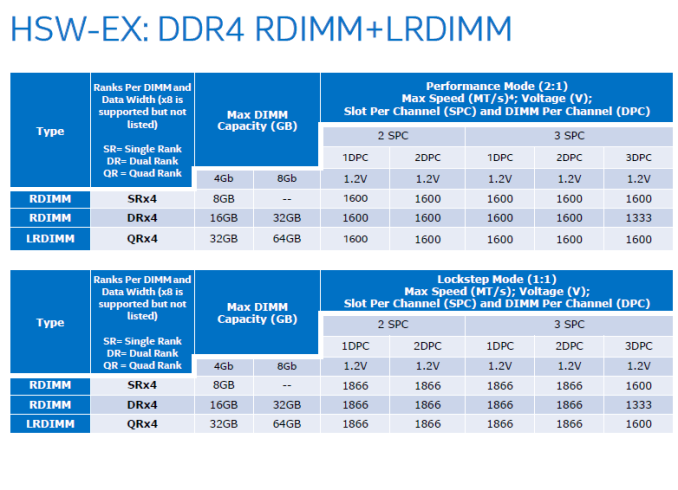








146 Comments
View All Comments
DanNeely - Friday, May 8, 2015 - link
Intel's 94% market share is still only ~184k systems. That's tiny compared to the mainstream x86 market; and doesn't give a lot of (budgetary) room to make radical changes to CPU vs just scaling shared designs to a huger layout.theeldest - Friday, May 8, 2015 - link
184k for 4S systems. The number of 2S systems *greatly* outnumbers the 184k.Samus - Sunday, May 10, 2015 - link
by 100 orders of magnitude, easily.2S systems are everywhere these days, I picked up a Lenovo 2S Xeon system for $600 NEW (driveless, 4GB RAM) from CDW.
4S, on the other hand, is considerably more rare and starts at many thousands, even with 1 CPU included.
erple2 - Sunday, May 10, 2015 - link
Well, maybe 2 orders of magnitude. 100 orders of magnitude would imply, based on the 184k 4S systems, more 2S systems than atoms in the universe. Ok, I made that up, I don't know how many atoms are in the universe, but 10^100 is a really big number. Well, 10^105, if we assume 184k 4S systems.I think you meant 2 orders of magnitude.
mapesdhs - Sunday, May 10, 2015 - link
Yeah, that made me smile too, but we know what he meant. ;)evolucion8 - Monday, May 11, 2015 - link
That would be right if Intel cores are wide enough which aren't compared to IBM. For example, according to this review, enabling two way SMT boosted the performace to 45% and adding two more threads added 30% more performance. On the other hand, enabling two way SMT on the latest i7 architecture can only go up to 30% on the best case scenario.chris471 - Friday, May 8, 2015 - link
Great article, and I'm looking forward to see more Power systems.I would have loved to see additional benchmarks with gcc flags -march=native -Ofast. Should not change stream triad results, but I think 7zip might profit more on Power than on Xeon. Most software is not affected by the implied -ffast-math.
close - Friday, May 8, 2015 - link
It reminds me of the time when Apple gave up on PowerPC in mobiles because the new G5s were absolute power guzzlers and made space heaters jealous. And then gave up completely and switched to Intel because the 2 dual core PowerPC 970MP CPUs at 2.5GHz managed to pull 250W of power and needed liquid cooling to be manageable.IBM is learning nothing from past mistakes. They couldn't adapt to what the market wanted and the more nimble competition was delivering 25-30 years ago when fighting Microsoft, it already lost business to Intel (which is actually only nimble by comparison), and it's still doing business and building hardware like we're back in the '70s mainframe age.
name99 - Friday, May 8, 2015 - link
You are assuming that the markets IBM sells into care about the things you appear to care about (in particular CPU performance per watt). This is a VERY dubious assumption.The HPC users MAY care (but I'd need to see evidence of that). For the business users, the cost of the software running on these systems dwarfs the lifetime cost of their electricity.
SuperVeloce - Saturday, May 9, 2015 - link
They surely care. Why wouldn't they. A whole server rack or many of them in fact do use quite a bit of power. And cooling the server room is very expensive.